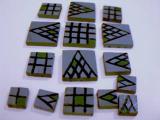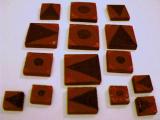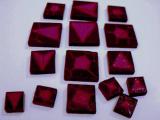



(Standardization is, if nothing else, a way to be sure that people with different sets can play together without confusion. If you want to ignore this stuff and make any kind of set you please, you think I'm going to stop you?)
Small pieces shall be 1/2 (0.5) inches square; medium pieces shall be 3/4 (0.75) inches square; large pieces shall be 1 (1.0) inch square. The thickness need not conform to a precise standard, but all pieces should be between 3/16 and 1/2 (0.1875 and 0.5) inches thick.
(Isn't the passive voice fun?)
Each piece shall have a "standing" pattern on one side and a "lying down" pattern on the other side. The exact forms of these patterns are left open to interpretation. However, some general rules must be followed:
The "lying down" pattern must have a recognizable overall form of a triangle, with the point in the center of one edge of the square, and the base covering the entire opposite edge.

The "standing" pattern can be any overall form which is symmetrical and centered on the face.

You can buy long strips of bass wood which are 1/2 by 3/16 inches, and 1 by 3/16 inches. If you can't get 3/4-inch wide strips, take a 1-inch strip, score a line with a razor blade, and then deepen the crack until it splits the long way.
Then start cutting squares. A small hacksaw or finger-length serrated knife is easier than a razor blade, since you're cutting across the grain. When you measure, remember that each cut chews out about 1/16 inch of wood.
My Zarcana pieces have so far endured several games of Zarcana. They worked fine.
Three of us have also tried playing Icehouse with the pieces. Of course, the shape makes a tremendous difference to that game. (Consider tip-blocking.) Only two game of Flat Icehouse have occurred thus far. The other two players tied in one game, and I didn't do well in the other; which makes me the Worst Flat Icehouse Player in the Universe. Sigh.
The games of Icehouse, Zarcana, and related games were invented by Andy Looney and John Cooper.
The Unofficial Icehouse Home Page.